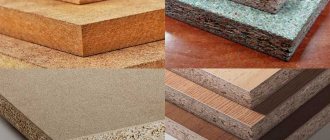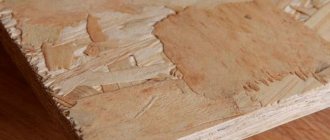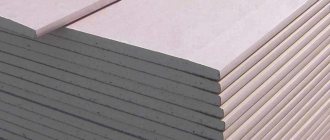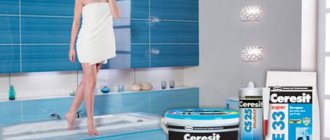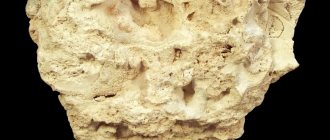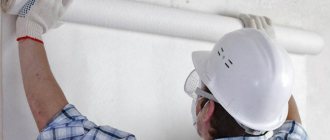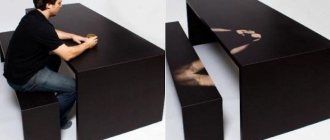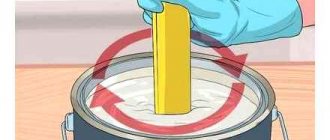Home page » Terms » Glass-magnesite sheet. Application and characteristics of LSU.
Author: Alexander Firtsev
Internet marketer, editor of the site “In an accessible language” Publication date: 07/06/2017
Glass-magnesite sheet (FMS) is an environmentally friendly sheet finishing material based on magnesium binder and fiberglass fabric. Sometimes the product is referred to as a “magnesium glass plate”.
The LSU includes the following components:
- magnesium oxide (38 - 40%);
- magnesium chloride (33 - 35%);
- wood shavings (14 - 15%), some manufacturers, instead of shavings, may add rice husks or wood flour;
- perlite (4 - 5%);
- binder composite materials (4-5%);
- fiberglass (up to 1%).
It is worth noting that changing the proportions and quality indicators of each of the components affects the physical, mechanical and operational characteristics of the finished product - for example, the amount of magnesium oxide used in production directly affects the density of the sheet, the amount of binding composite materials on its flexibility, and the strength of the used fiberglass has a direct impact on the strength of the structural material.
The main suppliers of raw materials for the production of sheets are: Russia, China and Mongolia.
The leader in production at the moment is China; production is also located in Canada and Russia.
Russian production facilities are located in Moscow, Moscow region, Samara, Kaluga and Tambov regions. In Russia, the most famous are the following: GEFEST LLC, ETOKON LLC.
LSU classes
Currently, manufacturers divide sheets into three classes:
- standard - used for interior decoration of premises with normal humidity levels.
- premium - can be used for both external and internal work, suitable for finishing.
- superpremium - used for both external and internal work in residential, office and industrial premises, excellent for lamination, veneering and painting.
- economy - found relatively rarely in manufacturers' nomenclatures. It is used to perform rough work in rooms with normal operation.
Polyvinyl chloride
Panels made of polyvinyl chloride have high fire-resistant properties. They ignite only at a temperature of about 400° C in the flame zone, but then go out on their own. When burning, carbon dioxide, poisonous carbon monoxide and hydrogen chloride vapor are released.
The last two components are toxic. A fire certificate on PVC panels confirms that they belong to class 3 materials. They should not be installed in most public establishments. PVC sheets are allowed for finishing residential premises, subject to strict compliance with all safety requirements.
Technical characteristics of LSU
Density: 1000-1400 kg/m3;
Water absorption is usually from 9 to 18%, depending on the manufacturer and class of sheet;
Thermal conductivity of SML: 0.28 W/m0C;
Frost resistance: depending on the quality, the sheet can withstand 30-52 freeze-thaw cycles;
The degree of sound insulation is about 44 dB;
Design bending resistance in dry condition - 17 MPa
Design bending resistance in wet condition - 21 MPa
Fire resistance is one of the main advantages of this material; glass-magnesite sheets can hold fire for 120 minutes and can also withstand heating up to 1200 degrees Celsius. Flammability classes according to GOST 30244 - A, B1, G1, NG.
Scope of use
The scope of application of the material is very extensive and includes:
- finishing of residential, retail, industrial, commercial and social premises;
- construction of improvised partitions, interior columns, arches, structures for zoning, etc.;
- arrangement of floors and suspended ceiling structures;
- use as mines for the further location of utilities;
- replacing plastic or wood for the construction of concrete slopes or doorways;
- application for the construction of a heat or sound insulating barrier indoors, etc.
Depending on the scope of application, the plates are divided into those intended for:
- Ceiling finishing – sheet thickness 0.3-0.5 cm;
- Wall finishing – thickness from 0.5 to 1 cm;
- Facade work – thickness 1 cm or more.
Glass-magnesium sheets have also found application in facade work, in particular, for the manufacture of permanent formwork for lightweight concrete mixtures or for direct cladding of the facade.
A magnesite sheet is installed by analogy with drywall. You just need to take into account that the slab should not be wet to ensure good flexibility and ease of cutting. In this case, installation involves leaving a gap with a width equal to half the thickness of the LSU.
Advantages
Based on the previously listed characteristics, the main advantages of glass-magnesite sheet include:
- Strength and flexibility. Due to this, it is used in complex structures, on curved surfaces. You can drive nails into the magnesite plate, use self-tapping screws and rivets.
- Hygiene. Due to the low degree of water absorption, the likelihood of mold and mildew occurring when used in wet areas is very low.
- Water resistance. Glass magnesite is not subject to deformation when in contact with moisture. Therefore, it can be used in places where there is high humidity. In swimming pools, showers, baths.
- Ease. Thanks to this property, the load on the frame structure and fastening connections is reduced, this is especially important when installing suspended structures and finishing ceilings.
- Not afraid of high temperatures.
- Resistance to ultraviolet rays. They can be used to decorate the façade of a building without decorative cladding.
- Frost resistance. It can be used in frame construction and permanent formwork.
- Good sound insulation properties.
- Excellent heat retention.
To visually compare the main characteristics of LSU with such sheet materials as: gypsum plasterboard, gypsum board, OSB boards, CBPB, chipboard, KNAUF sheets, the table below is presented:
Glass magnesite is easy to process. It can be sawed, sanded, cut. In this case, in most cases, no chips or cracks form, with the exception of low-quality sheets.
LSU has good adhesion (adhesion to the surface). Ceramic tiles, paint, and plaster also fit well on the sheets. They can be covered with wallpaper. They combine well with any sealants.
SML - glass-magnesium sheet - large overview
Glass-magnesium sheet is a modern, universal, multifunctional sheet material for external and internal decoration of residential and non-residential premises.
Magnesium glass sheet is made from environmentally friendly materials and is a completely safe building material for health. Magnesium glass sheet simultaneously has several unique qualities that make it a leading player in the construction market: strength, flexibility, moisture resistance, non-flammability, cleanliness; At the moment, no sheet material on the market has all these qualities at the same time. LSU has a very wide range of applications: external and internal finishing of residential and non-residential premises, industrial buildings, office premises, premises with high humidity: baths, saunas, swimming pools, showers; rapid construction of low-rise and high-rise buildings using glass-magnesium sheets as permanent formwork. Glass-magnesium sheet is an ideal replacement for plasterboard and other sheet materials, since, firstly, glass-magnesium sheet surpasses them in properties and breadth of application, and secondly, glass-magnesium sheet is sold at a more favorable price.
Various material names
Other names and abbreviations denoting one material are quite widespread: glass-magnesium sheet: sml, glass-magnesium sheet, sml sheet, glass-magnesite, glass-magnesite sheet, magnesite, xylolite-fiber sheet, kvl, magnesite sheet, magnesite plate, magnesite, magnesite. This variety of names is primarily due to the ambiguity in the translation of the foreign name of this material - Magnesium Oxide Board or Glass Magnesium Panel.
Properties of LSU
Strength of LSU . Magnesium glass sheet is a material with very high strength. The bending strength of glass-magnesium sheets in a dry state is at least 16 Mra (for comparison, the strength of plasterboard is 3 Mra). The strength of glass-magnesium sheet exceeds all wall materials. Such high characteristics allow you to drive nails into a glass-magnesium sheet (even using a pneumatic gun, which significantly saves time), screw in self-tapping screws, and even reuse the sheets. The glass-magnesium sheet is completely indestructible during proper transportation and allows the manufacture of structures of any complexity; the edges of the sheet are strong and do not crumble. During the processing and cutting of the glass-magnesium sheet, no chips or cracks occur; during installation, the sheet is tightly attached to the surface.
Moisture resistance of SML. Magnesium glass sheet is a very moisture-resistant material; this property allows it not to swell or deform even with prolonged exposure to water. The glass-magnesium sheet does not lose its properties even after 100 days of complete immersion in water, while after drying the geometric dimensions remain unchanged. The use of glass-magnesium sheets in bathhouses, swimming pools, showers and any other rooms with high humidity guarantees the preservation of the structural strength and quality of the sheet surface.
Fire resistance of SML. Magnesium glass sheet is a very resistant fire-resistant material. Glass-magnesium sheet of class Standard belongs to the flammability group G1 according to GOST 30244-94 (low-flammable, low-flammable material and material with low smoke-generating ability according to SNiP 21-01-97*). Premium class glass-magnesium sheet belongs to the NG (non-flammable) category, which is confirmed by several foreign certificates: GB/T19001-2000 and ISO9001:2000. According to GOST 30244-94, glass-magnesium sheet of Premium class belongs to the NG category (non-flammable). Before the advent of glass-magnesium sheets, there was no similar finishing and building material on the construction market with NG characteristics confirmed in accordance with GOST 30244-94. The high fire resistance of glass-magnesium sheets prevents ignition and further spread of fire in the event of a fire.
Sound and thermal insulation of SML. Magnesium glass sheet is an excellent sound and heat insulating material. It can be successfully used as an insulating material for exterior and interior decoration, with the possibility of applying various decorative coatings to it. Glass-magnesium sheet is suitable for thermal insulation of any premises, window slopes, window sills, showers, saunas. SML is excellent for soundproofing residential and non-residential premises of any type, cinema halls and studios (in combination with other modern soundproofing materials). With fairly low thermal conductivity and sound permeability, glass-magnesium sheets, together with modern insulating materials, can be successfully used as a material for exterior finishing of facades, with the possibility of applying various decorative coatings.
Environmental friendliness of SML. Magnesium glass sheet is an absolutely environmentally friendly material, there is not even a shadow of doubt about this. Magnesite (the main component of glass-magnesium sheets) is a natural mineral contained in the sheet without any additives. The glass-magnesium sheet is assigned the 4th hazard class, i.e. absolutely safe, harmless. The glass-magnesium sheet does not contain any harmful substances such as formaldehyde or phenol. For the production of LSU, mineral raw materials, plant fibers and other natural components are used. The radioactivity level is much lower than the maximum permissible norm by Gosstandart. The glass-magnesium sheet meets the environmental requirements of Gosstandart and is a material recommended for use. The compliance of the glass-magnesium sheet with sanitary rules is confirmed by a sanitary-epidemiological conclusion. Areas of use
Due to its unique properties, glass-magnesium sheet can be used instead of the usual fiberboard, chipboard, plywood, and flat slate. Magnesium glass sheets are a worthy replacement for gypsum fiber sheets and moisture-resistant plasterboard. In terms of the breadth of applications, glass-magnesium sheet has no analogues on the construction market: it is an excellent example of products of modern scientific and technical developments, it belongs to the category of lightweight finishing materials for interior and exterior work, with excellent fire-fighting and moisture-resistant properties. Due to its high moisture-resistant qualities and excellent adhesion, it can be used with virtually no further processing. The glass-magnesium sheet does not deform from moisture, high temperatures, or aggressive environments. Glass-magnesium sheet is convenient and can be used when installing walls, partitions, when finishing ceiling and wall surfaces, columns, slabs, and allows you to give the desired shape to curved surfaces. It is perfect as permanent formwork for frame house construction. Due to the antiseptic and moisture-resistant properties of magnesium compounds, glass-magnesium sheets can be used in domestic premises and dining rooms, in bathrooms and swimming pools, shops and administrative buildings, in any places where contact with food is possible and there is a possibility of developing fungal infections.
Today, in interior work, plasterboard and gypsum fiber sheets are mainly used. Depending on the type of building, a number of mandatory fire safety requirements apply to it. One of the most important is the fire resistance of walls and partitions, staircases and escape routes. For this purpose, two layers of plasterboard sheathing are often used, and fire resistance EI-45 is achieved. Using glass-magnesium sheet for these purposes provides a more effective and cost-effective option. The fire resistance of a partition based on 8mm glass-magnesium sheet is not less than EI-60. In this case, compared to plasterboard, cost savings of about 25-35% are achieved, installation time is reduced, in addition, partitions made of glass-magnesium sheets have a number of advantages in further processing and operation. Such partitions are moisture-resistant and frost-resistant.
Thus, SML can be used in the following cases:
- Interior decoration for decorative purposes of walls, ceilings, floors, installation of partitions
- Thermal and sound insulation of residential and commercial premises
- External cladding of facades and roofs of buildings, structures, shopping and commercial complexes
- Finishing walls, floors, ceilings in wet areas: saunas, swimming pools, bathrooms, basements and garages
- Creation of fireproof fire protection structures
- Construction of permanent formwork using glass-magnesium sheets
- Production of various sandwich panels with unique properties.
Features and Benefits
Magnesium glass sheet is more than 3 times stronger than plasterboard. LSU 6mm can be used where 8-10mm plasterboard is used (for example, ceilings): this contributes to a significant reduction in the weight of the structure, faster installation and it is cost-effective.
SML is very easy to process: it can be sawed with a hacksaw, a circular saw, and is easy to drill. The glass-magnesium sheet is suitable for driving nails even with a pneumatic gun. Cutting a glass-magnesium sheet is very simple: you just need to cut the fiberglass on the smooth side of the sheet and break it off at the point of the cut; uneven cuts can be easily cleaned with emery cloth. For a more even cut, it is recommended to use a power tool (jigsaw, grinder, etc.). Fastening a glass-magnesium sheet to a frame made of a metal profile or wood is carried out by analogy with the principles of fastening drywall. You cannot screw a self-tapping screw into a good quality glass-magnesium sheet without drilling; you need to either drill it or use self-tapping screws with notches that countersink themselves (this is either a self-tapping screw for gypsum plasterboard or a self-tapping screw for a window profile).
LSU retains its shape when wet (does not swell in water), is not subject to destruction, does not generate dust, easily withstands temperature changes, does not rot, and is not destroyed by fungal colonies, which provides it with excellent sanitary characteristics. The glass-magnesium sheet is completely odorless and does not emit toxic substances even with strong heating. The presence of all these properties prevents the appearance of mold and fungal formations, which is essential in rooms with high humidity: showers, saunas, swimming pools.
The glass-magnesium sheet is resistant to temperature changes, does not lose its geometry when frozen, and has already proven itself in low-rise housing construction as an external wall material. SML has excellent adhesion properties to all plaster mixtures. Paint, tiles, and plaster fit perfectly on it. It goes well with any building materials and with all known sealants: silicone, acrylic, etc.
When using glass-magnesium sheets, significant savings are achieved, both in terms of material costs and transportation costs. And all because where plasterboard is usually used in two layers, only one layer of glass-magnesium sheets (and thinner ones) can be used while maintaining (often improving) all the required design characteristics.
Two classes Premium and Standard
Premium class glass-magnesium sheet (class A) is used in cases where higher sheet strength is required: for so-called load-bearing structures, for example, for floors or permanent formwork. It is also recommended to use Premium for external finishing of facades, because... they are denser, more durable and have a low moisture absorption coefficient.
Glass-magnesium sheet Standard (class B) is used mainly for non-load-bearing structures: leveling walls (thickness recommendations: 6-8mm), constructing partitions (8-10mm), finishing ceilings (6mm), finishing slopes on windows (6mm), but can can also be used for flooring, using a thickness of 10-12mm (or an 8mm sheet in two layers).
Glass-magnesium sheet of class A can also be used for exterior work, provided that it is treated with a primer and special façade paints are used; no additional processing is required if you plan to sheathe glass-magnesium sheet with panels or siding.
Composition and production
The glass-magnesium sheet consists of:
- wood shavings (15%)
- magnesium oxide [MgO] (40%)
- magnesium chloride [MgCl2] (35%)
- perlite [SiO2] (5%) (volcanic glass)
- fine fiberglass (1%)
- binder composite materials (4%)
Note that for different manufacturers, the percentage of components included in the glass-magnesium sheet may differ by 1-2% up or down; above we have given the most common composition of glass-magnesium sheets. Stages of production of glass-magnesium sheets:
- Rolling on a machine
- Molding
- Lamination
- Storage
- Halogenation
- Flushing
- Drying
- Sizing adjustments
- Finishing, chamfering
- Package
The surface of the glass-magnesium sheet is covered on both sides with a reinforcing fiberglass mesh, which gives the sheet high strength characteristics. The front surface of the glass-magnesium sheet is very smooth, it is polished and completely ready for finishing, it can be painted, and any decorative materials can be glued to it: wallpaper, plaster, ceramic tiles, glass, mirrors, chipboard, plastic, aluminum composite panels. Glass-magnesium sheet has long been successfully used in China, the USA, Japan, England, and now it is increasingly winning the sympathy of builders in Russia, displacing such a familiar material as drywall.
Application of glass magnesite sheets
Glass-magnesite sheets are excellent for both interior and exterior work. They can be used when constructing partitions, leveling walls, floors and installing suspended ceilings. Due to its good flexibility, it can be used for mounting arches and structures with rounded surfaces.
LSUs are excellent for arranging sheathing for flexible tiles; the use of sheets as permanent formwork is also common.
Premium and super premium class sheets can be used for finishing as wall panels; for such purposes, manufacturers produce painted sheets.
A story about the use of glass magnesite in construction. Video by user "Saturn Vaynard" from Youtube.
Glass-magnesium plates: characteristics and features of the use of the material
Glass-magnesite sheet SML is very easy to process. The initial edge of the slab can be easily cut with a regular construction knife, after which the sheet must be bent in the opposite direction at the place where the cut was made. Then the bend is cut in the same way.
According to the flexibility criteria, the SML board resembles plasterboard, plywood, OSB, and DSP panels. Without moistening and heating, magnetite practically does not have this indicator.
Glass magnesite is a fairly flexible material, so it is easy to cut.
Due to their high level of moisture resistance, glass-magnesium boards can be used for treating rooms exposed to humidity: baths, saunas, shower rooms, swimming pools, as well as for any external finishing work. This construction sheet does not absorb water and does not change its structure, does not swell, does not crack from moisture during the operational period. According to laboratory studies, premium magnesite board does not change its properties even after 100 days in water.
Drywall: price per sheet, sizes, types of material (read more)
It should be noted that LSU sheets are environmentally friendly. To produce the material, only natural and natural substances are used that do not harm humans and the environment. Magnesite boards do not contain asbestos and other harmful components.
Magnesium glass plates are a very popular material today. This is primarily due to ease of installation. Magnelite is ideal for installation on both plasterboard profile systems and wooden frames. Fastening is carried out using self-tapping screws MN or TN 25-65. For these purposes, you can also use screws with a sharp drilling tip SN and SB 25-40.
In the case of using premium class A slabs, you need to do light drilling under the screw head. For other types of this material, namely for classes B - G, this need not be done, since the screw fits perfectly into the surface of the magnesite sheet. The exceptional strength of the SML board allows installation even with the help of ordinary nails and a pneumatic gun, which is absolutely unacceptable when using drywall.
Due to the characteristics of the magnesite surface, there is no need to prime the surface before filling.
The use of magnetite can significantly save money and time, since the surface of the material does not require priming before puttying, facing with ceramic tiles or wallpapering. And the sound insulation of a room lined with magnesite sheets doubles.
On a note! The SML board can be coated with vapor-permeable dyes. If you use waterproof paint, the top layer may swell and crack over time.
Installation of SML
LSU is mounted in almost the same way as drywall - it is screwed with self-tapping screws to profiles or beams pre-installed on walls or other structures. However, the only difference is that before screwing it in, you need to drill holes for self-tapping screws or self-tapping screws. The joints between the sheets can be filled with a mixture based on cement, acrylic, or silicone.
It is not recommended to cut glass-magnesite panels when wet.
When cutting, the panel should be positioned with the smooth side facing up.
Calcium silicate panels
It is known that of all natural substances, minerals do not burn at all. The stone buildings of our ancestors were not afraid of fire, unlike wooden huts. Gradually, houses began to be filled with more items that were not fire-resistant, and the risk of fire increased.
Now finishing with natural fire-resistant stone is very expensive. In addition, the consumer qualities of natural minerals are not suitable for all premises.
Many fire-resistant products have appeared on the market, which are based on inorganic substances. The price of such materials is affordable, the aesthetic and performance properties are varied, and are acceptable to many consumers.
Fire-resistant panels made of calcium silicates are as close in composition as possible to natural substances. Calcium salts are the basis of many rocks. Silicates and silicon oxide are widely distributed in nature.
Fire-resistant calcium silicate sheets (SCL) are environmentally friendly and do not contain artificial toxic impurities. The products do not absorb moisture and are resistant to bacterial contamination.
Finishing the building with fire-resistant calcium silicate panels reduces the fire hazard class to minimal. Sheets can be installed externally on facades, plinths, formwork; indoors for rooms of any functional load. SKL kitchen panels have ideal properties.
The sheets absorb sound waves well; they can be used to decorate nightclubs, dance and concert halls, and music studios. The acoustics of the premises will improve significantly after this finishing.
Increased fire resistance allows the use of SK panels for thermal insulation of baths, stoves, fireplace inserts, and kitchen stoves. The product is characterized by amazing elasticity for a mineral material and is easily fixed to any surface thanks to fastening devices. Fire-resistant sheets are offered in an assortment and have different external designs.
Prices for glass magnesite sheets
According to data published in open sources, as of July 2021, the cost of glass-magnesite sheets from manufacturers and suppliers varies within the following limits:
| Thickness | Standard | Premium | Superpremium |
| 6 mm. | 170-200 rub./sq.m. | 200-220 rub./sq.m. | 255-280 rub./sq.m. |
| 8 mm. | 180-210 rub./sq.m. | 230-260 rub./sq.m. | 310-330 rub./sq.m. |
| 10 mm. | 210-230 rub./sq.m. | 260-280 rub./sq.m. | 360-380 rub./sq.m. |
| 12 mm. | 240-270 rub./sq.m. | 300-220 rub./sq.m. | 440-480 rub./sq.m. |
Notes:
- Price lists from manufacturers and suppliers indicate the cost per piece, the area of which can vary from 2.88 to 3.11 square meters. The cost is for reference only and is calculated as the average value of prices presented on the websites of Russian manufacturers and suppliers.
- No information was found on the price of sheets with a thickness of more than 12 mm (presented in reference literature) at the time of writing.
- The price is for unpainted and non-laminated panels.
Glass magnesite
SML glass-magnesite panels are also made from natural raw materials, which contain magnesium carbonates and oxides. The mineral contains silicon oxides - silica, magnesium silicates.
Magnesite fire-resistant panels are reinforced with glass fibers, so their rigidity is slightly greater than that of SKL. This quality of glass-magnesium material allows it to be used in the finishing of roofs, billboards, and other materials of increased strength.
Magnesite composite is not infected with bacteria, which makes it convenient for the manufacture of multilayer materials. SML products help to increase the fire resistance of the sandwich panels in which they are included. At the same time, the ventilation, hygienic and acoustic qualities of the material do not deteriorate.
Interesting tests
Test for knowledge of Russian history
How well do you know the history of Russia?
Test: is the emphasis in words correct?
So is it still ringing or is it ringing?
Attention and memory test
There are a lot of trick questions in this test!
Geography test
Find out how well you know geography!
Drywall and gypsum vinyl
Fire-resistant panels made of special plasterboard are usually designated gypsum board. The material has affordable prices and a high level of heat resistance. During a 20-minute stay in proximity to an open flame, they do not light up. Fire-fighting qualities are imparted to plasterboard by special additives - fire retardants.
The material is very light, resistant to moisture, and is in great demand. GKLO does not have an external decorative layer. Each buyer can design sheets according to their wishes and capabilities.
Fire-resistant panels are sometimes classified as gypsum vinyl products. There are many modifications of such sheets with different ratios of the original components. Representatives of the group with a large mass fraction of gypsum have high resistance to fire, as indicated on the labeling.
Such fire-resistant panels differ from many others in their increased strength. They can be installed in places with high mechanical load and risk of abrasion.
How to determine the quality of LSU
Popular manufacturers correctly indicate the classiness of their products because they protect the company’s reputation. However, there are also lesser-known manufacturers who offer lower cost products. Below are some tips on how to independently determine your LSU class:
- the leaf should be beige or yellowish in color. A white or gray tint to the product indicates low quality. The latter may contain fine dust on the surface;
- high-quality material has durable edges;
- a bad leaf, after placing it in water for a couple of hours, will make it cloudy;
- if there is interlining on the back side of the sheet, then the quality of the product is low. This component reduces the strength and fire-resistant properties of glass magnesite.
Approximate prices
Class A “Premium” sheet, used for outdoor work. Prices for it depend on thickness. For a 6 mm sheet measuring 1220x2440 mm, sellers ask from 400 to 420 rubles. LSU with a thickness of 8 mm is sold at prices from 440 to 470 rubles. 10 mm – 580 – 620 rub., 12 mm – 670 – 730 rub./sheet.
Average prices for LSU “Standard”:
- 6 mm – 320 -340 rub./sheet;
- 8 mm – 340-360 rub./sheet;
- 10 mm – 380-430 rub./sheet;
- 12 mm - 440-460 rub./sheet.
“Economy” class sheets are sold on average 5-8% cheaper than “Standard” ones.
